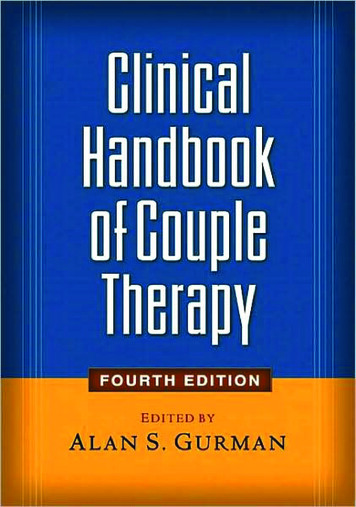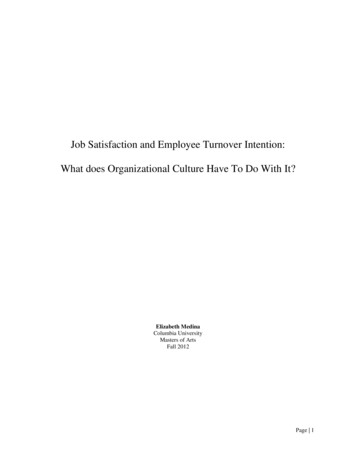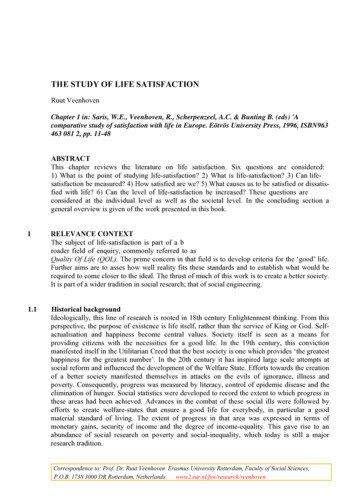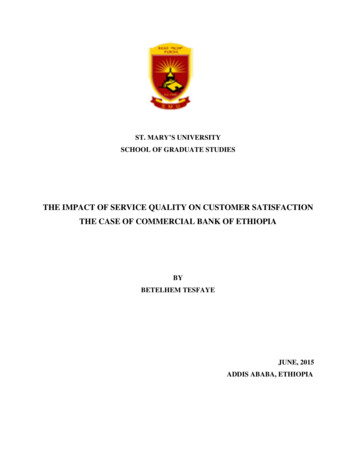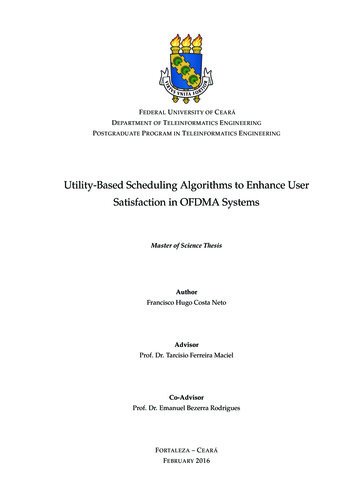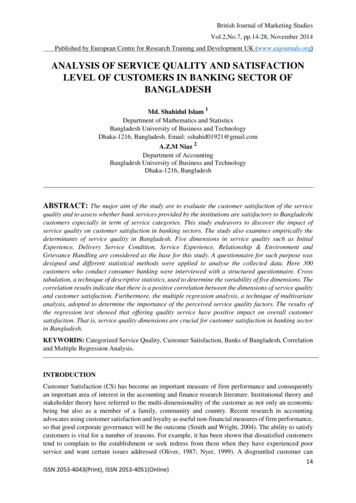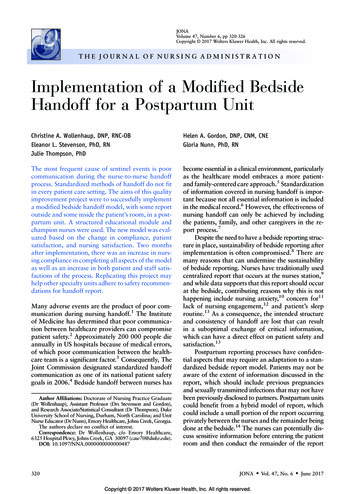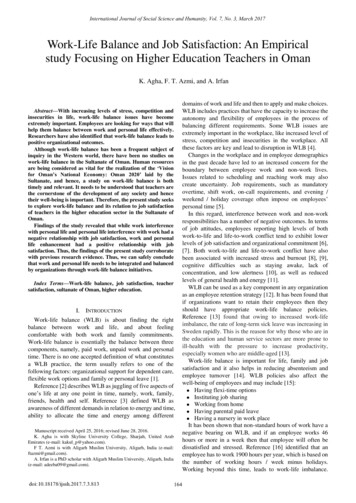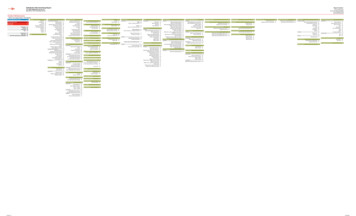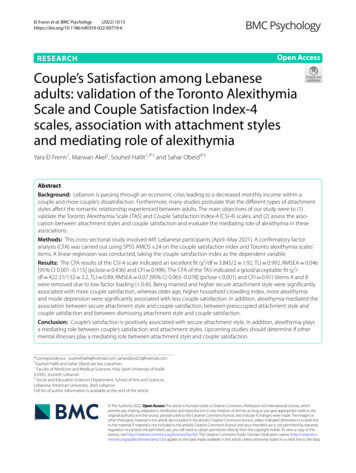
Transcription
(2022) 10:13El Frenn et al. BMC -6Open AccessRESEARCHCouple’s Satisfaction among Lebaneseadults: validation of the Toronto AlexithymiaScale and Couple Satisfaction Index‑4scales, association with attachment stylesand mediating role of alexithymiaYara El Frenn1, Marwan Akel2, Souheil Hallit1,3*† and Sahar Obeid4*†AbstractBackground: Lebanon is passing through an economic crisis leading to a decreased monthly income within acouple and more couple’s dissatisfaction. Furthermore, many studies postulate that the different types of attachmentstyles affect the romantic relationship experienced between adults. The main objectives of our study were to (1)validate the Toronto Alexithymia Scale (TAS) and Couple Satisfaction Index-4 (CSI-4) scales, and (2) assess the association between attachment styles and couple satisfaction and evaluate the mediating role of alexithymia in theseassociations.Methods: This cross-sectional study involved 445 Lebanese participants (April–May 2021). A confirmatory factoranalysis (CFA) was carried out using SPSS AMOS v.24 on the couple satisfaction index and Toronto alexithymia scales’items. A linear regression was conducted, taking the couple satisfaction index as the dependent variable.Results: The CFA results of the CSI-4 scale indicated an excellent fit (χ2/df 3.845/2 1.92, TLI 0.992, RMSEA 0.046[95% CI 0.001–0.115] (pclose 0.436) and CFI 0.998). The CFA of the TAS indicated a good/acceptable fit (χ2/df 422.31/132 3.2, TLI 0.89, RMSEA 0.07 [95% CI 0.063–0.078] (pclose 0.001) and CFI 0.91) (items 4 and 8were removed due to low factor loading ( 0.4)). Being married and higher secure attachment style were significantlyassociated with more couple satisfaction, whereas older age, higher household crowding index, more alexithymiaand mode depression were significantly associated with less couple satisfaction. In addition, alexithymia mediated theassociation between secure attachment style and couple satisfaction, between preoccupied attachment style andcouple satisfaction and between dismissing attachment style and couple satisfaction.Conclusion: Couple’s satisfaction is positively associated with secure attachment style. In addition, alexithymia playsa mediating role between couple’s satisfaction and attachment styles. Upcoming studies should determine if othermental illnesses play a mediating role between attachment style and couple satisfaction.*Correspondence: souheilhallit@hotmail.com; saharobeid23@hotmail.com†Souheil Hallit and Sahar Obeid are last coauthors1Faculty of Medicine and Medical Sciences, Holy Spirit University of Kaslik(USEK), Jounieh, Lebanon4Social and Education Sciences Department, School of Arts and Sciences,Lebanese American University, Jbeil, LebanonFull list of author information is available at the end of the article The Author(s) 2022. Open Access This article is licensed under a Creative Commons Attribution 4.0 International License, whichpermits use, sharing, adaptation, distribution and reproduction in any medium or format, as long as you give appropriate credit to theoriginal author(s) and the source, provide a link to the Creative Commons licence, and indicate if changes were made. The images orother third party material in this article are included in the article’s Creative Commons licence, unless indicated otherwise in a credit lineto the material. If material is not included in the article’s Creative Commons licence and your intended use is not permitted by statutoryregulation or exceeds the permitted use, you will need to obtain permission directly from the copyright holder. To view a copy of thislicence, visit http:// creat iveco mmons. org/ licen ses/ by/4. 0/. The Creative Commons Public Domain Dedication waiver (http:// creat iveco mmons. org/ publi cdoma in/ zero/1. 0/) applies to the data made available in this article, unless otherwise stated in a credit line to the data.
El Frenn et al. BMC Psychology(2022) 10:13Page 2 of 10Keywords: Attachment styles, Couple satisfaction, Alexithymia, Relationship satisfaction, Validation, TorontoAlexithymia Scale, Couple Satisfaction Index-4, Depression, LebanonBackgroundCouple satisfaction is the subjective evaluation of one’srelationship; it is interpreted by the assessment of thepositive feelings for one’s partner, the satisfaction withthe relationship and its overall appraisal [1]. It is affectedby many factors such as depression [2], relationship education [3], sexual communication [4], sexual satisfaction[5] and individual’s educational level [6]. Culture diversity is another factor that influences relationship satisfaction; collectivistic culture, similar to the Lebanese one,is characterized by fidelity, support and partnership thatimpact the couple’s relation. In contrast, in individualisticculture like the one present in Western countries, satisfaction is not correlated with meeting individual’s obligations but rather is attained when the couple’s goals areaccomplished [7].Moreover, depression, a major cause of disabilityworldwide [8], is associated with couple’s satisfaction[2]. As stated by the World Health Organization (WHO),more than 300 million people are affected by depression[9]. A study showed that 59.7% of the Lebanese population suffer from depression [10], and other mental healthillnesses such as anxiety [11] and suicidal ideation [12].Instability in the couple satisfaction was shown to berelated to depressive symptoms severity [2].Additionally, attachment styles affect couple satisfaction [13]. It presupposes that the primary relationshipwith the parents, starting from meeting one’s needs anddeveloping a response mechanism, impacts the way ofcommunication with the outer world [14]. In fact, attachment styles are known as an inborn human potential tocorrelate with one’s caregiver; hence, young childrenneed to develop a relationship with at least one primarycaregiver for a healthy social and emotional development[15]. From here, interpersonal bonds in adulthood arevigorously affected and determined by the attachmentrelationship background [16]. The most significant partof the attachment theory elucidates that people unconsciously generalize what has been already acquired in theearly years; the bonding established between two personsin the early stage of development, affects the quality ofbonding later in adulthood [17, 18]. Bartholomew andHorowitz classified attachment styles into four different categories: secure, preoccupied, dismissive and fearful [19]. Securely attached individuals are usually knownto be self-confident, trusting, hopeful, and responsiveto intimate relationship. Fearful persons may find it difficult to connect to others, or are anxious thinking theywill face failure or be rejected by their partner. For people with the preoccupied type, they are often anxious anduncertain, and lack self-esteem as they worry that theymight be unwanted by others. For the dismissive type, theperson is so wary of closeness and try to avoid emotionalconnection with others, thus, may not look for a relationship [19]. A constructive association between secureattachment and couple satisfaction was demonstratedby most researchers, and a negative correspondencebetween insecure attachment and couple satisfaction[20–23]. Some people find the idea of connecting andbonding with others distressing and uncomfortable;this falls under the category of social phobia and anxiety illness [24]. Previous studies in Lebanon tackled therelationship between attachment styles and alcohol usedisorder [25, 26], mental health illnesses such as alexithymia, anxiety, depression [27] and fear of intimacy [28],but none of them tackled their relationship with couple’ssatisfaction.According to the type of attachment style, one can discover the degree of emotional regulation; thus, peoplewith insecure attachment style have greater levels of alexithymia [29]. Each of the partners should acknowledgeand value the feelings of each other in order to maintain ahealthy couple relationship. Hence, individuals with alexithymia are negatively associated with couple’s satisfaction [30]. Alexithymia is characterized by the inability toidentify and describe emotions experienced by one’s self[31, 32]. People with alexithymia find it hard to controltheir emotions which are linked with low levels of socialability, emotion expression and intelligence [33]. The percentage of alexithymia was recorded high in Lebanonas 20.8% of the population suffer from this illness [34].Alexithymia has a moderator role between attachmentstyles and couple satisfaction: this disorder reduces indirectly the relationship satisfaction [35] and is linked tothe fearful and preoccupied styles rather than the secureattachment style [36, 37]. A Lebanese study estimated thefactors that are linked with alexithymia among the population; and came to a realization that tension, emotionaland mental fatigue, alcohol addiction and anxiety arelinked with more alexithymia, but being married is linkedwith less alexithymia [34]. Another study conducted inLebanon showed that insecure attachment styles arelinked positively to alexithymia, in opposite to the secureone that is negatively linked to alexithymia [27].Lebanon is passing through an economic crisis [38]leading to a decreased monthly income within a couple
El Frenn et al. BMC Psychology(2022) 10:13and more couple’s dissatisfaction [39]. Furthermore,many studies postulate that the different types of attachment styles affect the romantic relationship experiencedbetween adults [40, 41]. Also, there are no studies inLebanon about that subject and about the mediating roleof alexithymia in these associations. The main objectivesof our study were to (1) validate the Toronto Alexithymia Scale (TAS) and Couple Satisfaction Index-4 (CSI-4)scales, and (2) assess the association between attachmentstyles and couple satisfaction and evaluate the mediating role of alexithymia in these associations. We hypothesize that secure attachment style would be linked withhigher couple satisfaction, in opposite to insecure attachment styles; and that alexithymia would increase couple’sdissatisfaction in individuals with insecure attachmentstyles.MethodsStudy design and participantsThis cross-sectional study involved 445 Lebanese participants between April and May 2021. The snowball technique was followed during the data collection; a Googleform was designed and distributed via social mediato persons from all Lebanese districts (Beirut, Bekaa,Mount Lebanon, South Lebanon and North Lebanon).These persons were asked to forward that link to otherfriends they know. All participants were informed aboutthe objective of this study and the anonymity of participation. Participants had the freedom to accept or declinethe invitation, with no monetary compensation receivedfor participation. All methods were carried out in accordance with relevant guidelines and regulations.Minimal sample size calculationThe G-power system was used to calculate the minimalsample size required based on an alpha error of 5%, apower of 80% and 12 factors to be entered in the multivariable analysis. The minimal sample size required was395 participants.Ethical approvalThis study protocol was approved by the Psychiatric Hospital of the Cross Ethics and Research Committee (HPC020-2021). Submitting the form online was consideredequivalent to obtaining a written consent.QuestionnaireThis survey was created in the native language of Lebanon (Arabic). Twenty minutes were required to completethe form. It was divided to several sections:Page 3 of 10Sociodemographic characteristicsThis section included questions about individuals’ age,gender, educational level, marital status and HouseholdCrowding Index (HCI). The HCI was obtained by dividing the number of persons living in the house by thenumber of rooms in the house [42].Couple Satisfaction Index‑4 (CSI‑4)It is composed of 4-items to measure the relationship satisfaction in couples [43]. Each item is graded from 0 (notat all) to 5 (absolutely). The higher the score, the higherthe satisfaction of the couple. The Cronbach’s alpha inthis study was 0.872.Toronto alexithymia scale (TAS 20)Alexithymia was evaluated by using the 20-item TorontoAlexithymia Scale [44]. It has an adequate validity andcredibility [45, 46]. Each item is calculated by usingthe 5-point Likert scale (from 1 strongly disagree to5 strongly agree). Professor Graeme Taylor gave us thepermission to use this scale and provided us with its Arabic version. The Cronbach’s alpha in this study was 0.913.The relationship questionnaireEach item describes one of the four types of the adultattachment styles: secure (style A), preoccupied (styleB), fearful (style C), and dismissing (style D) [47]. Eachitem is graded on a 7-point scale (1 strongly disagreeto 7 strongly agree). The Cronbach’s alpha in this studywas 0.76.Lebanese Depression Scale (LDS‑19)This is a 19-item scale, validated in Lebanon and usedto assess the symptoms and signs of depression amongthe Lebanese population [48]. The higher the score, thehigher the depression. The Cronbach’s alpha in this studywas 0.921.Translation procedureThe translation from English to Arabic was carried outby a single bilingual translator for the couple satisfactionindex scale and relationship questionnaire. A backwardtranslation was then performed by another translator, fluent in Arabic and unfamiliar with the concepts ofthe scales. Discrepancies were resolved by consensusbetween translators and researchers.Statistical analysisA confirmatory factor analysis (CFA) was carried outusing SPSS AMOS v.24 on the couple satisfaction indexand Toronto alexithymia scales’ items. The root meansquare error of approximation (RMSEA) statistic, theTucker Lewis Index (TLI) and the comparative fit index
El Frenn et al. BMC Psychology(2022) 10:13Page 4 of 10Table 1 Sociodemographic characteristics of the participants (N 445)VariableN (%)GenderMale146 (32.8%)Female299 (67.2%)Marital statusSingle (but in a serious relationship)321 (72.2%)Married124 (27.8%)Education levelSecondary or less321 (72.2%)University124 (27.8%)Mean SDAge (in years)28.38 13.26Number of children1.13 1.98Household crowding index1.33 0.94Alexithymia57.11 9.22Depression15.77 12.50Couple satisfaction index(CFI) were used to evaluate the goodness-of-fit of themodel as these are the most commonly used indices[49]. Values of RMSEA of 0.06 or less indicate a goodfitting model and a value larger than 0.10 is indicativeof a poor model [49], while TLI and CFI values greaterthan 0.90 indicate excellent model fit [49], whereas TLIvalues 0.85 [49] and CFI values 0.80 [50] indicate goodmodel fit.The SPSS software v.25 was used for all statisticalanalysis. The normality of distribution of the couple satisfaction index was confirmed via a calculation of theskewness and kurtosis; values for asymmetry and kurtosis between 1 and 1 are considered acceptable inorder to prove normal univariate distribution [51]. Theseconditions consolidate the assumptions of normality insamples larger than 300 [52]. The Student t test was usedto test for an association between the score and dichotomous variables. Finally, the Pearson correlation testwas used to correlate two continuous variables. A linearregression was conducted, taking the couple satisfactionindex as a dependent variable.The PROCESS SPSS Macro version 3.4, model four[54] was used to calculate three pathways. Pathway Adetermined the regression coefficient for the effect ofeach attachment style on alexithymia (mediator); Pathway B examined the association between alexithymiaand couple’s satisfaction, and Pathway C’ estimated thetotal and direct effect of each attachment style and couple’s satisfaction. A mediation was deemed significant ifthe bootstrapped 95% confidence intervals of the indirectpathway AB did not pass by zero. Variables that showed9.69 5.47a p 0.25 in the bivariate analysis were taken as independent ones in the linear and mediation models [53].1p 0.05 was deemed statistically significant.ResultsThe sample consisted of 445 participants, with a meanage of 28.38 13.26 years and 67.2% females. Other characteristics and description of the scores can be found inTable 1.Confirmatory factor analysis of the couple satisfactionindexThe following results were obtained: the MaximumLikelihood Chi-Square 3.845 and Degrees of Freedom 2, which gave a χ2/df 1.92. The TLI value was0.992. The RMSEA value was 0.046 [95% CI 0.001–0.115](pclose 0.436) and CFI value was 0.998 respectively,indicating an excellent fit of the model. Table 2 presentsthe coefficients with standard errors and p-values of thedirect effects of variables on each other.1In the paper of Bursac et al., 2008 (link: https:// scfbm. biome dcent ral. com/ artic les/ 10. 1186/ 1751- 0473-3- 17), authors state that variables that shouldbe entered in a logistic regression model are the ones that show a p 0.25.We contacted Pr. Hosmer and Pr. Lemeshow who said that these assumptions would likely hold for linear regression, but to date there is no publishedresearch examining this criteria for variable selection.
El Frenn et al. BMC Psychology(2022) 10:13Page 5 of 10Table 2 Item descriptive statistics, standardized factor loadings,and explained variance of the couple satisfaction indexTable 4 Correlation between the couple satisfaction index andother continuous variablesVariableStandardized factor Standard errorloadingspVariableCSI 11CSI 20.84 13CSI 30.930.14 0.001Secure attachment style0.1960.910.14 0.001Preoccupied attachment style 0.033Fearful attachment styleDismissing attachment styleStandardized factor Standard errorloadingspFactor 1TAS 2TAS 110.7180.076 0.0010.5960.072 0.001TAS 170.5090.077 0.001Factor 2Number of childrenVariable0.5730.066 0.001Marital statusTAS 60.6800.072 0.001Single (but in a seriousrelationship)Mean SDTAS 70.7620.068 0.0010.7800.069 0.001Married 0.001Education level 0.001Secondary or less0.0680.070UniversityFactor 310.724pEffect size0.99009.69 5.36FemaleTAS 9TAS 100.816 0.001 0.193Gender1TAS 50.5920.054Numbers in bold indicate significant p-valuesTAS 30.651 0.025 0.011Household crowding indexTAS 1TAS 140.4870.015 0.092Male0.698 0.001Table 5 Correlation between the couple satisfaction index andother categorical variables1TAS 12TAS 13 0.0010.115AgeVariable 0.001 0.197 0.195CSI 4Table 3 Item descriptive statistics, standardized factor loadings,and explained variance of the couple satisfaction indexp9.69 5.54 0.0010.4980.0340.2598.96 5.4111.60 5.199.42 5.4810.82 5.32The Student t test was used to compare two means0.097 0.001TAS 150.4190.082 0.001TAS 160.4800.088 0.001TAS 180.6930.096 0.001TAS 190.7430.097 0.001TAS 200.4250.087 0.001Confirmatory factor analysis of the Toronto AlexithymiaScaleItems 4 and 8 were removed due to low factor loading ( 0.4). The following results were obtained forthe remaining items: the Maximum Likelihood ChiSquare 422.31 and Degrees of Freedom 132, whichgave a χ2/df 3.2. The TLI value was 0.89. The RMSEAvalue was 0.07 [95% CI 0.063–0.078] (pclose 0.001)and CFI value was 0.91 respectively, indicating a good/acceptable fit of the model. Table 3 presents the coefficients with standard errors and p-values of the directeffects of variables on each other.Bivariate analysisHigher alexithymia, depression, and household crowding index were significantly associated with lower couple satisfaction index, whereas higher secure and fearfulattachment styles were significantly associated with morecouple satisfaction index (Table 4). Furthermore, married participants and those with a university level of education had significantly higher couple satisfaction indexthan single and those with a secondary level of educationor less respectively (Table 5).Multivariable analysisThe results of a linear regression using the ENTER modeland taking the couple’s satisfaction index as the dependent variable, showed that being married (Beta 0.29) andhigher secure attachment style (Beta 0.16) were significantly associated with more couple satisfaction, whereasolder age (Beta 0.28), higher household crowdingindex (Beta 0.22), more alexithymia (Beta 0.16)
El Frenn et al. BMC Psychology(2022) 10:13Page 6 of 10Table 6 Multivariable analysis: linear regression taking the couple satisfaction index as the dependent variableVariableUnstandardized betaStandardized betap95% confidence intervalMarital status (married vs single*)3.590.29 0.0012.38 to 4.81Education level (university vs secondary orless*)0.230.020.699 0.95 to 1.42 0.12 0.28 0.001 0.09 0.160.001AgeHousehold crowding indexAlexithymiaDepressionSecure attachment stylePreoccupied attachment styleFearful attachment styleDismissing attachment style 0.22 0.001 0.120.0090.160.002 0.27 0.090.1370.080.139 0.21 0.060.221 1.29 0.050.470.27 0.16 to 0.07 1.79 to 0.79 0.15 to 0.04 0.09 to 0.010.17 to 0.78 0.62 to 0.09 0.09 to 0.62 0.56 to 0.13*Reference groupand mode depression (Beta 0.12) were significantlyassociated with less couple’s satisfaction (Table 6).Mediation analysisThe detailed results of the mediation analysis betweenattachment styles, alexithymia and couple satisfactionare summarized in Table 7. The results showed that alexithymia mediated the association between secure attachment style and couple satisfaction by 19.19%, betweenpreoccupied attachment style and couple satisfactionby 27.80% and between dismissing attachment style andcouple satisfaction by 17.32%.DiscussionOur study results showed that being married and havinghigher secure attachment style were positively associated with more couple satisfaction. However, older age,higher household crowding index, having more alexithymia and depressive symptoms were associated with lesscouple satisfaction. Moreover, alexithymia mediated theassociations between secure, preoccupied and dismissingattachment styles and couple satisfaction.Attachment styles and couple satisfactionHigher secure attachment style was significantly associated with more couple satisfaction, in line with previousstudies [55, 56]. In fact, individuals with secure attachment style are characterized by higher self-esteem, trustin others [57–59] and are comfortable expressing theiraffection for their partner [55]. This positive attitude aperson holds toward himself/herself and others increasescouple satisfaction, leading to a healthy communicationwith one another [55]. A healthy couple life is generatedby a purposeful bonding between the two of them as theyface stressful events with compassion and support byperforming acceptance and consensus [60].Alexithymia and couple satisfactionSimilar to a previous study [30], our results showed thatalexithymia was negatively associated with couple’s satisfaction. This result proposes that discomfort in emotionalcloseness is usually reflected by relationship dissatisfaction, which is associated with more alexithymia [61]. Thisdifficulty in recognition of emotion outcomes in the lackof clear uttering of feelings and compliance between thecouple as it initiates anger and anxiousness which maximizes couple conflicts [60].Depression and couple satisfactionFurthermore, depression was negatively associated withcouple’s satisfaction in our study, in line with previousfindings [2, 62]. Depressed individuals are more prone tonegative thoughts, thus, in relationships, they considerthemselves as rejected and despicable in the eyes of theirpartner who they think are unsupportive and discouraging [63].Mediating role of alexithymiaThis study showed that alexithymia played a mediating role between couple satisfaction and different typesof the attachment style. Relationship quality is deeplyassociated with its emotional aspects as it is differentlyevaluated and defined by people with secure and insecure attachment styles. Secure people express intimacy,love and friendship, while insecure ones have a contradiction and a pessimistic view of a relationship as theyconsider it as emotionally distancing and anxious [60].Therefore, individuals with insecure attachment styleslack the capacity to live their own real sentiments, feelthat happiness is unreachable to them and having anoptimistic view of life seems impossible [60]; the oppositeis true about people with a secure attachment style [60].
0.410.860.99 0.94 0.090.340.45 1.460.911.381.54 0.42Numbers in bold indicate significant xithymiaPreoccupiedAlexithymiaSecure1.603.233.57 3.530.560.111 0.070.001 0.11 0.26 0.11 0.10 0.37 0.11 0.001 0.001Model 1: Attachment style, alexithymia and couple satisfaction indexp 0.17 0.55 0.17 0.38 0.16 0.69 0.170.2595% BCa CI0.03 0.06 0.060.24 0.05 0.040.86 0.06 3.97 1.75 4.11 0.44 3.69 2.223.57 4.11t 0.0010.08 0.0010.661 0.0010.026 0.001 0.001p 0.30 0.17 0.470.66Beta 0.60 0.48 0.790.360.97 0.010.14 0.1595% BCa CI4.24 2.03 1.06 2.85tBetatBeta95% BCa CIEffect of attachment style and alexithymia on couple Effect of attachment style on couplesatisfaction indexsatisfaction indexEffect of attachment style on alexithymiaTable 7 Mediation analysis0.0430.2900.004 0.001p17.32%–27.80%19.19%Mediatingeffect ofalexithymiaEl Frenn et al. BMC Psychology(2022) 10:13Page 7 of 10
El Frenn et al. BMC Psychology(2022) 10:13The capacity of setting and keeping up a romantic relationship needs the identification of emotions and theirexpressions, as well as the understanding of others’ feelings [64–66]. Therefore, alexithymia has a positive relationship with difficulty in communication and bondingwith others [67].Sociodemographic characteristicsIn line with a previous study [68], being married is associated with more couple satisfaction. This result showsthat in a relationship, gladdening each other’s need forlove, glorifying togetherness, familiarity and daily interaction, help boost couple’s satisfaction [69].In line with a previous study [70], having a highercrowding index is associated with lower couple’s satisfaction. Economic stress and low levels of economicwell-being may exacerbate financial conflicts and lowergratifications as couples struggle to make ends meet[70]. However, some poor couples adjust well to theirrestricted assets, while some richer couples might in anycase have periodic hardships taking care of their financialobligations [70].Our study showed that being older was negatively associated with couple’s satisfaction. No studies have mentioned this relationship between the two variables. Wehypothesize that individuals with older age face morestressful events (such as retirement, decreased income,etc.), which can affect their living condition and consequently lead to less couple’s satisfaction. However, further studies are needed to show the exact cause of thisassociation.Limitations and suggestions for future researchSome limitations are present in this study. The crosssectional type used cannot demonstrate causation. Sampling bias exists since the data was collected through asnowball technique via social media. The questionnairewas self-administered, thus information bias is presentbecause the variables were not assessed by a healthcareprofessional. Our study did not include the length of therelationship length, which has been proved to be associated with couple’s satisfaction [71]. The results of thisstudy should be interpreted with caution since the fourparagraphs of the attachment styles questionnaire contain several sentences and participants do not always howto respond, which affects the validity of the questionnaire[71]. Also, other variables associated with couple’s satisfaction that were not assessed in this study, may lead toconfusion bias. However, we think that our results aresolid enough since they rely on validated scales. Upcoming studies should determine if other mental illnessesplay a mediating role between attachment style and couple satisfaction.Page 8 of 10ConclusionCouple’s satisfaction was positively associated withsecure attachment style. In addition, alexithymiaplayed a mediating role between couple’s satisfaction and attachment styles, which highlights the needto stage interventions to reduce alexithymia as well asengage social support. However, the mediating role ofalexithymia varied according to the different types ofattachment styles. Improving people’s coping mechanisms and resilience when facing their problems (suchas the economic crisis in our current situation in Lebanon, etc.) in general and in alexithymic individuals andthose with insecure attachment styles in particular,might help them decrease distress, which in turn canimprove their couple’s satisfaction [72]. Furthermore,alexithymic individuals can benefit from psychological therapeutic methods to improve their social connectedness (the awareness of an individual that he/sheis engaged in a social relationship), thus, leading to apositive personality and increasing life satisfaction [73].AbbreviationsWHO: World Health Organization; FOI: Fear of intimacy; TAS-20: Toronto Alexithymia Scale (TAS 20); CSI-4: Couple Satisfaction Index-4; LDS-19: LebaneseDepression Scale.AcknowledgementsWe would like to thank all participants who helped us during this project.Authors’ contributionsSO and SH designed the study; YEF drafted the manuscript; SH carried out theanalysis and interpreted the results; MA was responsible for the data collection; SO and SH reviewed the manuscript; All authors read and approved thefinal manuscript.FundingNone.Availability of data and materialsThe authors do not have the right to share any data information as per theirinstitutions policies.DeclarationsEthics approval and consent to participateThis study protocol was approved by the Psychiat
analysis (CFA) was carried out using SPSS AMOS v.24 on the couple satisfaction index and Toronto alexithymia scales' items. A linear regression was conducted, taking the couple satisfaction index as the dependent variable. Results: The CFA results of the CSI-4 scale indicated an excellent t (χ 2/df 3.845/2 1.92, TLI 0.992, RMSEA 0.046

